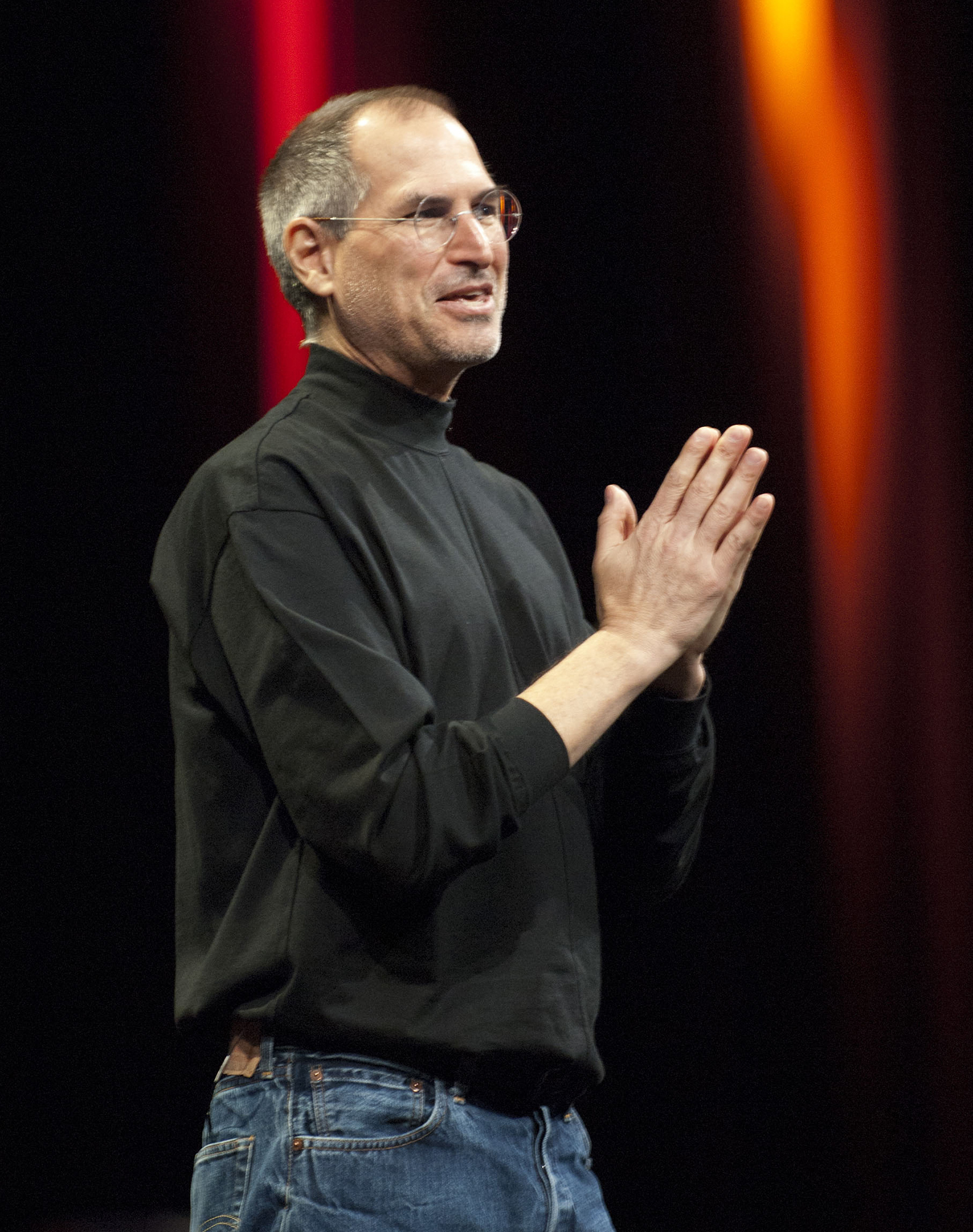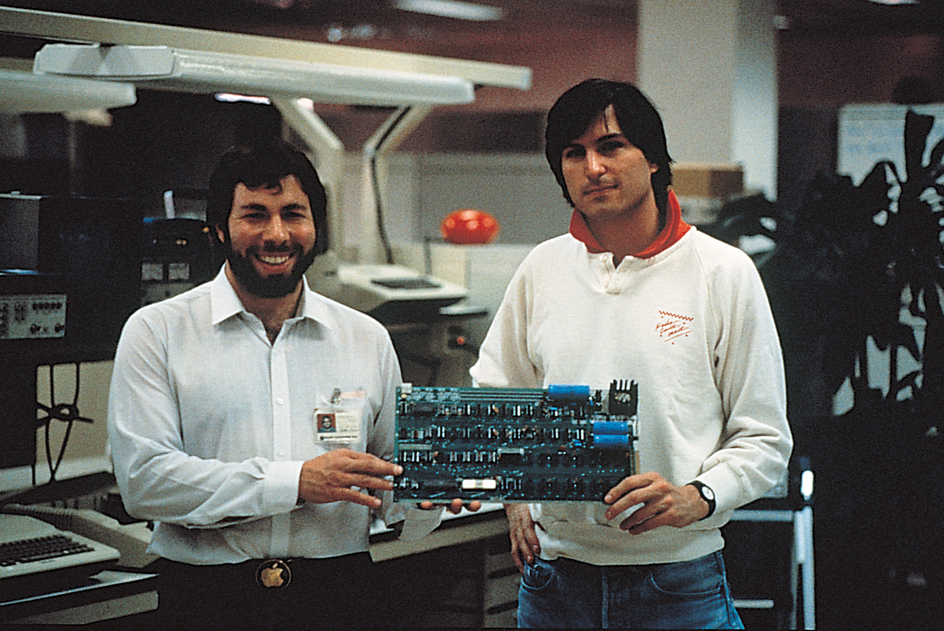Jobs << jobs >>, Steve (1955-2011), cofounded Apple Inc.—formerly known as Apple Computer, Inc.—with his friend Steve Wozniak. Under Jobs’s leadership, Apple introduced a steady stream of revolutionary electronic devices. They included the Macintosh computer, the iPod digital music player, the iPhone, and the iPad tablet computer.

While Wozniak focused on engineering Apple’s early computers, Jobs’s talent lay in product innovation and marketing. Jobs developed a reputation as a master showman. Dressed in his signature clothes—jeans and a black turtleneck—Jobs promoted new, innovative Apple products on stage in front of an awestruck crowd. Jobs’s keen eye for product design, and his intolerance for imperfection, helped make Apple the most valuable technology company in the world at the time of his death in 2011.
Early life.
Steven Paul Jobs was born in San Francisco, California, on Feb. 24, 1955. His father, a Syrian immigrant named Abdulfattah Jandali, and his Wisconsin-born mother, Joanne Schieble, gave him up for adoption. Paul and Clara Jobs adopted the boy. When Steve was 5 years old, the family moved to Mountain View, California, in an area that eventually became known as Silicon Valley. Steve and his adopted father often worked on electronics projects together in the garage. As a teen, Jobs met Steve Wozniak, who was also interested in electronics, and the two became good friends.

In their youth, Jobs and Wozniak experimented with electronic circuits. They also enjoyed pranks, and they figured out how to mimic the sound quality of a switching circuit on the telephone system. They developed what they called the “Blue Box,” a device that could replicate the sound of a circuit and make free telephone calls. Jobs and Wozniak sold the illegal devices for $150 each. But after being held up at gunpoint during a sale, the young men gave up their unlawful business.
Jobs began attending Reed College in 1972, but dropped out after one semester. He briefly worked at the gaming company Atari. Intrigued by spiritual ideas popular in the hippie movement, Jobs traveled to India. There, he lived a meager existence, seeking enlightenment. However, Jobs soon returned to the United States.
The birth of Apple.
Upon his return, Jobs renewed his friendship with Wozniak, who was working at Hewlett-Packard. Jobs returned to Atari. Both became members of a hobbyist group called the Homebrew Computer Club. Wozniak had created a computer circuit board, which became an instant hit at the club.

Jobs saw the business potential for selling computer kits and began marketing and selling the units, though Wozniak had to construct each one from scratch. Jobs and Wozniak decided to call their new company the Apple Computer Company, which was established in 1976. Jobs was the chairman and CEO, and Wozniak was the chief engineer. They named their first product the Apple I, which was released the same year.
In the 1970’s, the idea of a personal computer was in its infancy. Most computers were giant machines owned and run by large organizations. Small computers for the home were designed as kits for hobbyists who knew enough about electronics to assemble them. In 1977, Apple released a new computer designed by Wozniak called the Apple II. It was successfully marketed as easy for anyone to operate, even people without electronics expertise. Apple’s success began to shift the personal computer market away from a hobbyist’s pursuit. When the company began selling stock in 1980, it raised more capital than any other company in history, except for the Ford Motor Company in 1956. Jobs, Wozniak, and some of the other early employees became millionaires.
Growth and decline.
In 1981, Wozniak was injured in a plane crash, and he took a leave of absence from the company. Under Jobs’s direction, Apple continued to release successful, innovative computers. In 1983, Apple introduced the Lisa, named after Jobs’s daughter. The Lisa was the first commercial computer to feature a graphical user interface (GUI) and a mouse. A GUI is a system that enables users to interact with a computer by using icons and other visual elements displayed on a screen. Earlier computers required users to interact with a machine by typing text. Now, users could navigate the screen using a mouse and a pointer. Apple’s famous Macintosh computer, released in 1984, popularized the GUI system. To entice consumers, Apple spent $1.5 million on a flashy ad for the Macintosh during the Super Bowl—at that point, the most money ever spent on a television commercial. The commercial was only aired once.
Even though Jobs had overseen much growth at Apple, he became known as a contentious and difficult person. He had a particularly troubled relationship with the company’s upper management. In addition, the Macintosh did not sell well. In 1985, Jobs was forced to resign from the company. Wozniak’s influence at Apple had diminished, and he left the company in the same year to start a remote-control manufacturing company.
Exile and return.
Jobs started a new computer company called NeXT Inc. It focused on educational and business markets. But NeXT was not successful.
Jobs did make a fortune investing in the entertainment industry, however. In 1986, Jobs bought a division of Lucasfilm, a special-effects studio that eventually became known as Pixar Animation Studios. The studio released many blockbuster motion pictures, including Toy Story (1995) and A Bug’s Life (1998). Jobs served as its CEO until 2006.
Meanwhile, Apple continued to release expensive, sleek-looking products. But the company started to lose money. In 1997, Apple’s board asked Jobs to return as CEO.
As head of Apple once again, Jobs oversaw the development of many iconic electronic devices. The iPod, a digital music player released in 2001, helped popularize the distribution of music as files downloaded over the internet. The iPhone, released in 2007, featured a touch screen with intuitive, gesture-based controls, paving the way for a new class of phone-based mobile apps (programs). These products often had less powerful hardware—and higher price tags—than competing devices. Some criticized Apple’s closed software systems as overly restrictive. But the products’ simplicity and innovative controls won over consumers.

Death.
In 2003, Jobs was diagnosed with pancreatic cancer. A staunch believer in alternative medicine, he attempted to design his own treatment. But his declining health forced him to resign in August 2011. Jobs died on Oct. 5, 2011.
Since his death, Jobs has become an iconic figure. He has been the subject of several popular biographical books and films. In 2022, Jobs was posthumously awarded the Presidential Medal of Freedom, the highest civilian honor awarded by the president of the United States.
